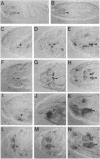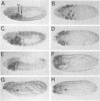Abstract
Deformed (Dfd) is a Drosophila homeotic selector gene required for normal development of maxillary segment morphology in the larval and adult head. Consistent with this function, Dfd transcripts are restricted to epidermal, mesodermal and neural cells in the embryonic mandibular and maxillary primordia. Previous studies have identified a far upstream element in Dfd sequences which functions as an epidermal-specific autoregulatory enhancer. In a search through 35 kb of Dfd sequences for additional transcriptional control elements, we have identified a 3.2 kb DNA fragment containing an enhancer that mimics the expression of Dfd in the subesophageal ganglion of the embryonic central nervous system. This Neural autoregulatory enhancer (NAE) maps in the large Dfd intron just upstream of the homeobox exon and requires Dfd protein function for its full activity. A 608 bp NAE subfragment retains regulatory function that is principally localized in the subesophageal ganglion. This small region of the Drosophila melanogaster genome contains numerous blocks of sequence conservation with a comparable region from the Dfd locus of D.hydei. A pair of conserved blocks of NAE sequence match a Dfd protein binding site in the epidermal autoregulatory element, while another conserved sequence motif is repeated multiple times within the 608 bp subelement.
Full text
PDF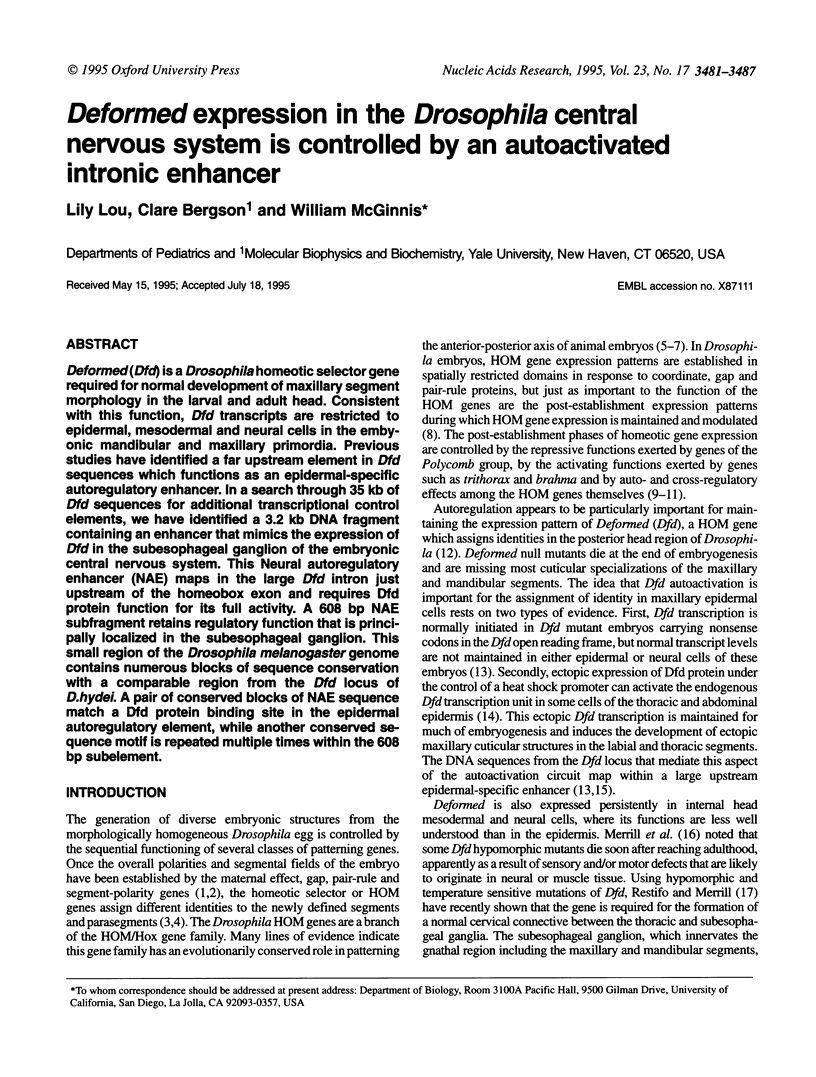
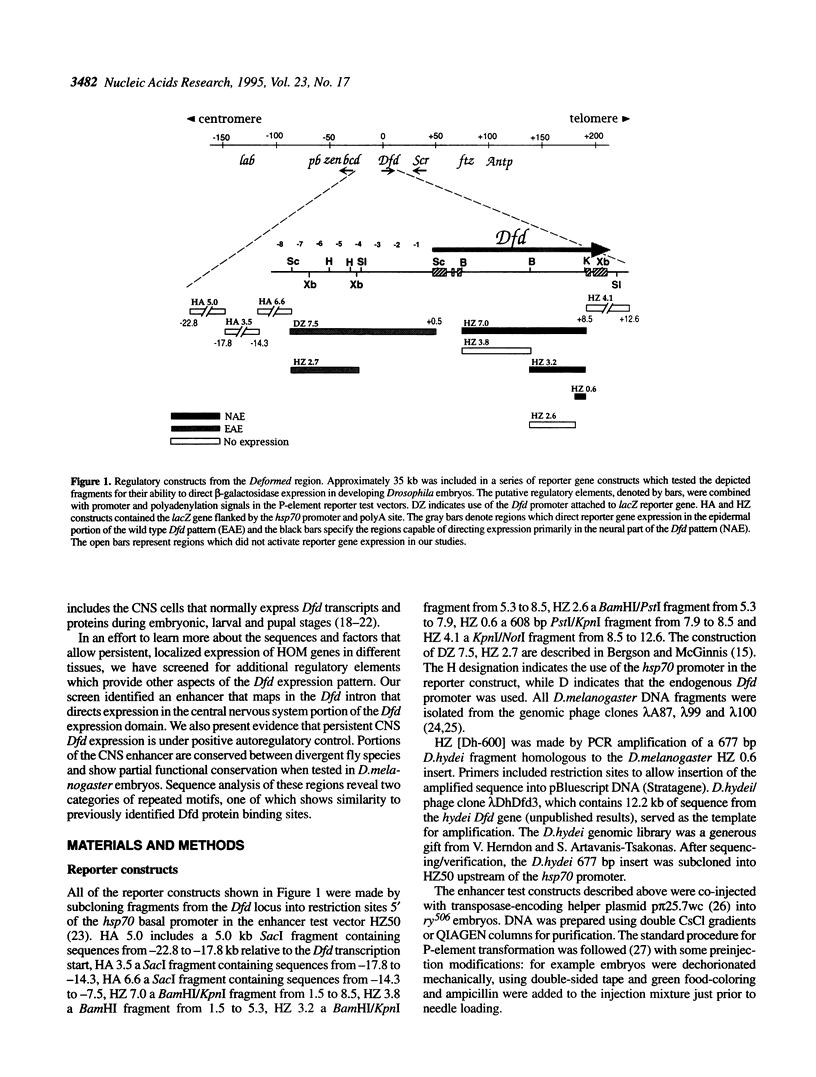
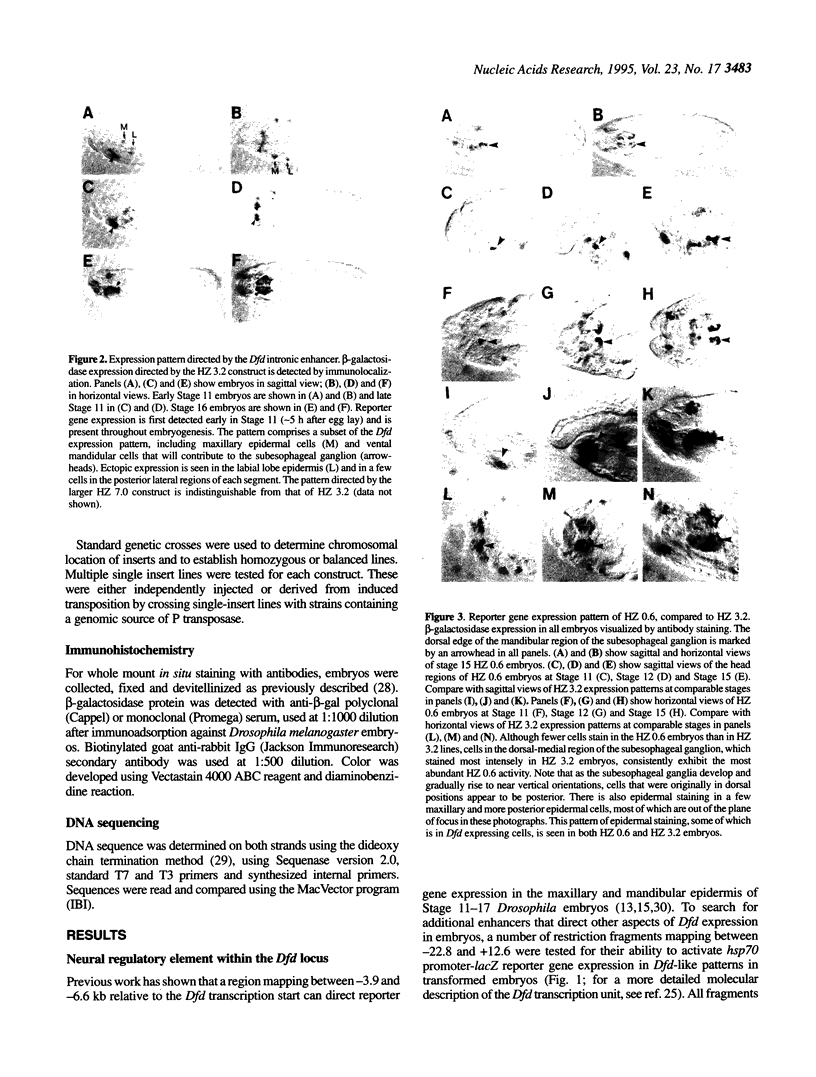
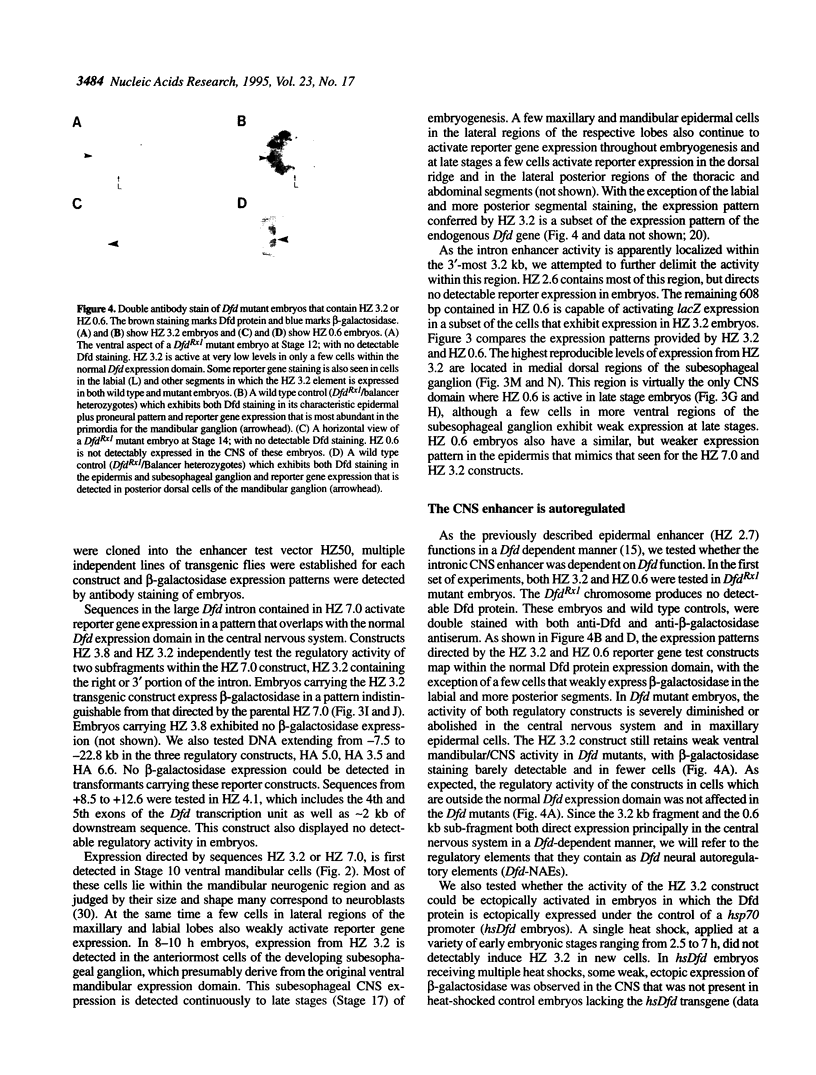
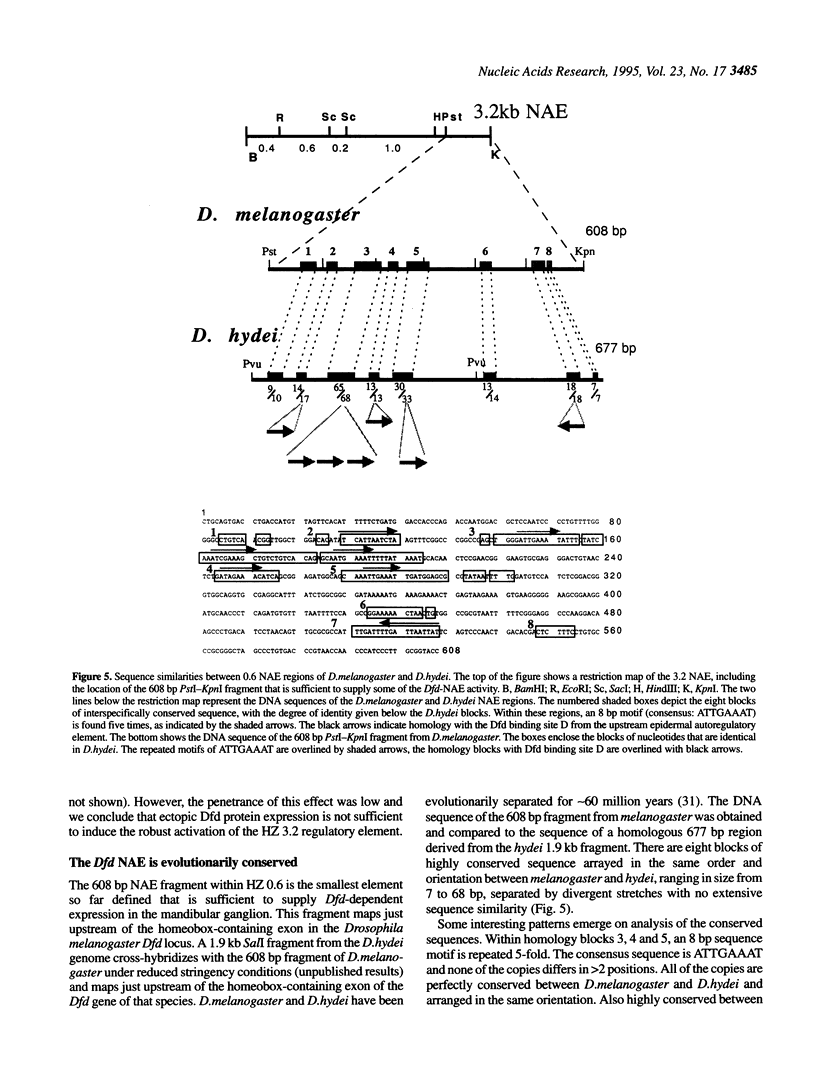
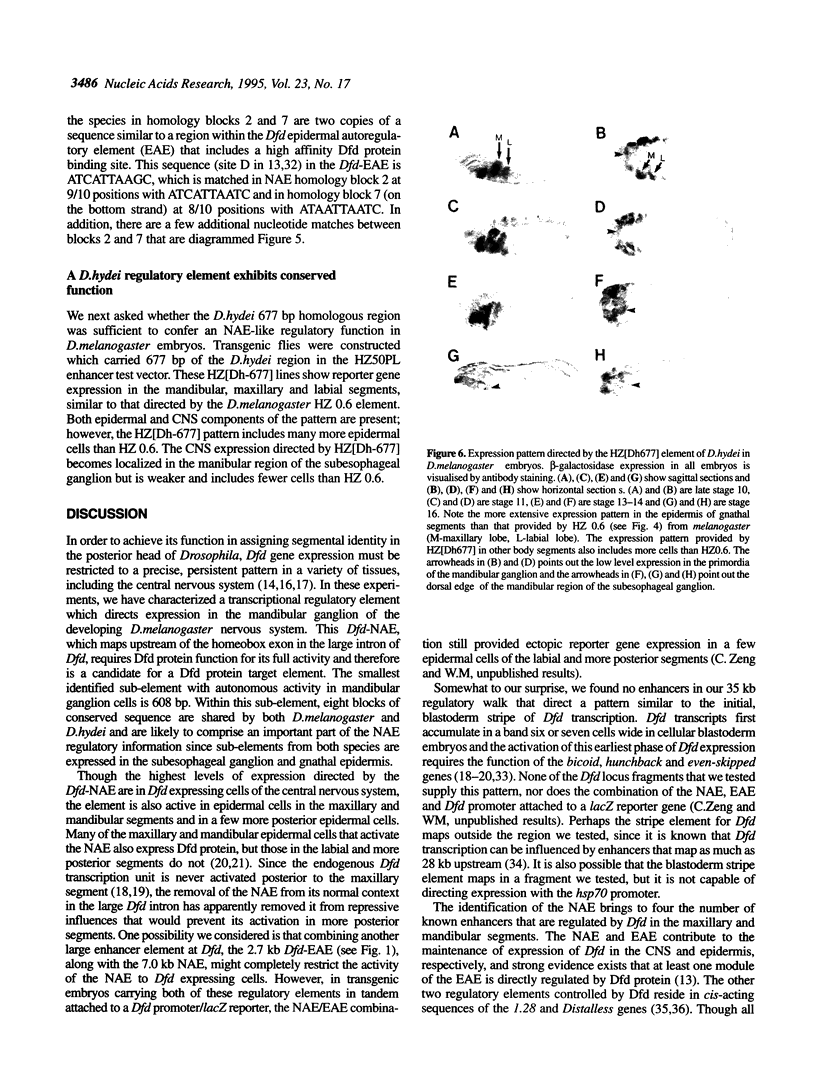
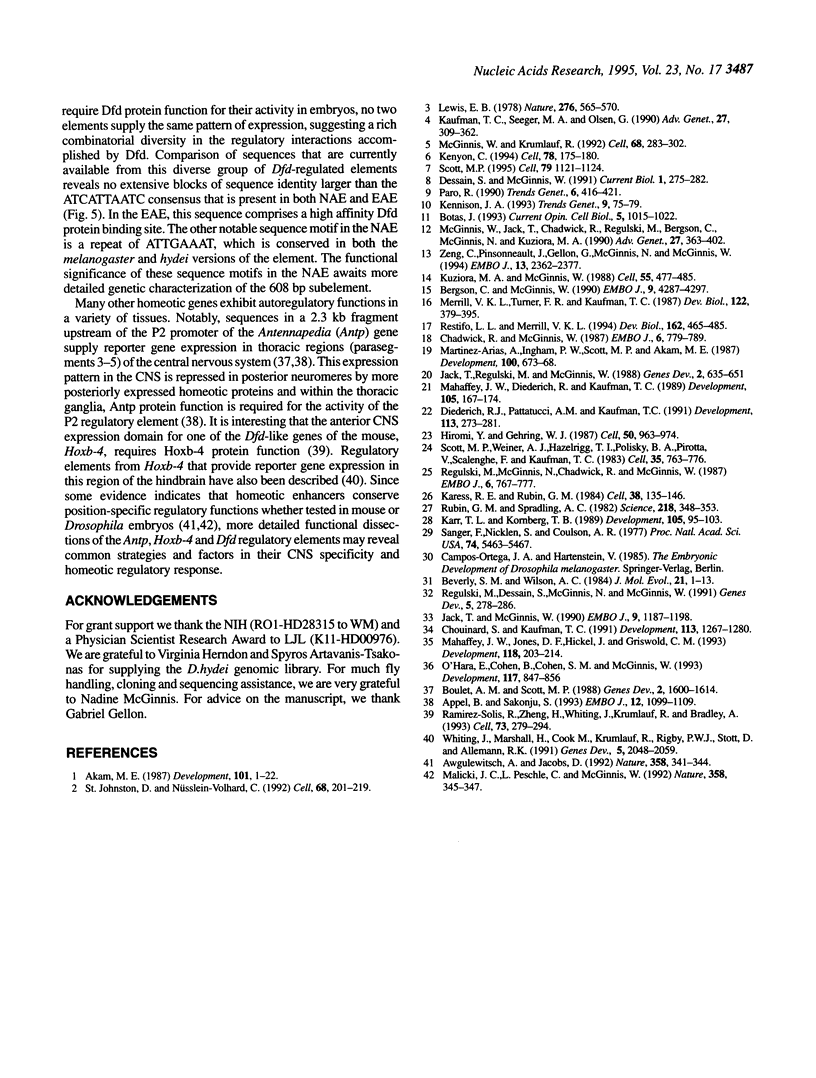
Images in this article
Selected References
These references are in PubMed. This may not be the complete list of references from this article.
- Akam M. The molecular basis for metameric pattern in the Drosophila embryo. Development. 1987 Sep;101(1):1–22. [PubMed] [Google Scholar]
- Appel B., Sakonju S. Cell-type-specific mechanisms of transcriptional repression by the homeotic gene products UBX and ABD-A in Drosophila embryos. EMBO J. 1993 Mar;12(3):1099–1109. doi: 10.1002/j.1460-2075.1993.tb05751.x. [DOI] [PMC free article] [PubMed] [Google Scholar]
- Awgulewitsch A., Jacobs D. Deformed autoregulatory element from Drosophila functions in a conserved manner in transgenic mice. Nature. 1992 Jul 23;358(6384):341–344. doi: 10.1038/358341a0. [DOI] [PubMed] [Google Scholar]
- Bergson C., McGinnis W. An autoregulatory enhancer element of the Drosophila homeotic gene Deformed. EMBO J. 1990 Dec;9(13):4287–4297. doi: 10.1002/j.1460-2075.1990.tb07877.x. [DOI] [PMC free article] [PubMed] [Google Scholar]
- Beverley S. M., Wilson A. C. Molecular evolution in Drosophila and the higher Diptera II. A time scale for fly evolution. J Mol Evol. 1984;21(1):1–13. doi: 10.1007/BF02100622. [DOI] [PubMed] [Google Scholar]
- Botas J. Control of morphogenesis and differentiation by HOM/Hox genes. Curr Opin Cell Biol. 1993 Dec;5(6):1015–1022. doi: 10.1016/0955-0674(93)90086-6. [DOI] [PubMed] [Google Scholar]
- Boulet A. M., Scott M. P. Control elements of the P2 promoter of the Antennapedia gene. Genes Dev. 1988 Dec;2(12A):1600–1614. doi: 10.1101/gad.2.12a.1600. [DOI] [PubMed] [Google Scholar]
- Chadwick R., McGinnis W. Temporal and spatial distribution of transcripts from the Deformed gene of Drosophila. EMBO J. 1987 Mar;6(3):779–789. doi: 10.1002/j.1460-2075.1987.tb04820.x. [DOI] [PMC free article] [PubMed] [Google Scholar]
- Chouinard S., Kaufman T. C. Control of expression of the homeotic labial (lab) locus of Drosophila melanogaster: evidence for both positive and negative autogenous regulation. Development. 1991 Dec;113(4):1267–1280. doi: 10.1242/dev.113.4.1267. [DOI] [PubMed] [Google Scholar]
- Dessain S., McGinnis W. Regulating the expression and function of homeotic genes. Curr Opin Genet Dev. 1991 Aug;1(2):275–282. doi: 10.1016/s0959-437x(05)80082-6. [DOI] [PubMed] [Google Scholar]
- Diederich R. J., Pattatucci A. M., Kaufman T. C. Developmental and evolutionary implications of labial, Deformed and engrailed expression in the Drosophila head. Development. 1991 Sep;113(1):273–281. doi: 10.1242/dev.113.1.273. [DOI] [PubMed] [Google Scholar]
- Hiromi Y., Gehring W. J. Regulation and function of the Drosophila segmentation gene fushi tarazu. Cell. 1987 Sep 11;50(6):963–974. doi: 10.1016/0092-8674(87)90523-x. [DOI] [PubMed] [Google Scholar]
- Jack T., McGinnis W. Establishment of the Deformed expression stripe requires the combinatorial action of coordinate, gap and pair-rule proteins. EMBO J. 1990 Apr;9(4):1187–1198. doi: 10.1002/j.1460-2075.1990.tb08226.x. [DOI] [PMC free article] [PubMed] [Google Scholar]
- Karess R. E., Rubin G. M. Analysis of P transposable element functions in Drosophila. Cell. 1984 Aug;38(1):135–146. doi: 10.1016/0092-8674(84)90534-8. [DOI] [PubMed] [Google Scholar]
- Karr T. L., Kornberg T. B. fushi tarazu protein expression in the cellular blastoderm of Drosophila detected using a novel imaging technique. Development. 1989 May;106(1):95–103. doi: 10.1242/dev.106.1.95. [DOI] [PubMed] [Google Scholar]
- Kaufman T. C., Seeger M. A., Olsen G. Molecular and genetic organization of the antennapedia gene complex of Drosophila melanogaster. Adv Genet. 1990;27:309–362. doi: 10.1016/s0065-2660(08)60029-2. [DOI] [PubMed] [Google Scholar]
- Kennison J. A. Transcriptional activation of Drosophila homeotic genes from distant regulatory elements. Trends Genet. 1993 Mar;9(3):75–79. doi: 10.1016/0168-9525(93)90227-9. [DOI] [PubMed] [Google Scholar]
- Kenyon C. If birds can fly, why can't we? Homeotic genes and evolution. Cell. 1994 Jul 29;78(2):175–180. doi: 10.1016/0092-8674(94)90288-7. [DOI] [PubMed] [Google Scholar]
- Kuziora M. A., McGinnis W. Autoregulation of a Drosophila homeotic selector gene. Cell. 1988 Nov 4;55(3):477–485. doi: 10.1016/0092-8674(88)90034-7. [DOI] [PubMed] [Google Scholar]
- Lewis E. B. A gene complex controlling segmentation in Drosophila. Nature. 1978 Dec 7;276(5688):565–570. doi: 10.1038/276565a0. [DOI] [PubMed] [Google Scholar]
- Mahaffey J. W., Diederich R. J., Kaufman T. C. Novel patterns of homeotic protein accumulation in the head of the Drosophila embryo. Development. 1989 Jan;105(1):167–174. doi: 10.1242/dev.105.1.167. [DOI] [PubMed] [Google Scholar]
- Mahaffey J. W., Jones D. F., Hickel J. A., Griswold C. M. Identification and characterization of a gene activated by the deformed homeoprotein. Development. 1993 May;118(1):203–214. doi: 10.1242/dev.118.1.203. [DOI] [PubMed] [Google Scholar]
- Malicki J., Cianetti L. C., Peschle C., McGinnis W. A human HOX4B regulatory element provides head-specific expression in Drosophila embryos. Nature. 1992 Jul 23;358(6384):345–347. doi: 10.1038/358345a0. [DOI] [PubMed] [Google Scholar]
- Martinez-Arias A., Ingham P. W., Scott M. P., Akam M. E. The spatial and temporal deployment of Dfd and Scr transcripts throughout development of Drosophila. Development. 1987 Aug;100(4):673–683. doi: 10.1242/dev.100.4.673. [DOI] [PubMed] [Google Scholar]
- McGinnis W., Jack T., Chadwick R., Regulski M., Bergson C., McGinnis N., Kuziora M. A. Establishment and maintenance of position-specific expression of the Drosophila homeotic selector gene Deformed. Adv Genet. 1990;27:363–402. doi: 10.1016/s0065-2660(08)60030-9. [DOI] [PubMed] [Google Scholar]
- McGinnis W., Krumlauf R. Homeobox genes and axial patterning. Cell. 1992 Jan 24;68(2):283–302. doi: 10.1016/0092-8674(92)90471-n. [DOI] [PubMed] [Google Scholar]
- Merrill V. K., Turner F. R., Kaufman T. C. A genetic and developmental analysis of mutations in the Deformed locus in Drosophila melanogaster. Dev Biol. 1987 Aug;122(2):379–395. doi: 10.1016/0012-1606(87)90303-4. [DOI] [PubMed] [Google Scholar]
- O'Hara E., Cohen B., Cohen S. M., McGinnis W. Distal-less is a downstream gene of Deformed required for ventral maxillary identity. Development. 1993 Mar;117(3):847–856. doi: 10.1242/dev.117.3.847. [DOI] [PubMed] [Google Scholar]
- Paro R. Imprinting a determined state into the chromatin of Drosophila. Trends Genet. 1990 Dec;6(12):416–421. doi: 10.1016/0168-9525(90)90303-n. [DOI] [PubMed] [Google Scholar]
- Ramírez-Solis R., Zheng H., Whiting J., Krumlauf R., Bradley A. Hoxb-4 (Hox-2.6) mutant mice show homeotic transformation of a cervical vertebra and defects in the closure of the sternal rudiments. Cell. 1993 Apr 23;73(2):279–294. doi: 10.1016/0092-8674(93)90229-j. [DOI] [PubMed] [Google Scholar]
- Regulski M., Dessain S., McGinnis N., McGinnis W. High-affinity binding sites for the Deformed protein are required for the function of an autoregulatory enhancer of the Deformed gene. Genes Dev. 1991 Feb;5(2):278–286. doi: 10.1101/gad.5.2.278. [DOI] [PubMed] [Google Scholar]
- Regulski M., McGinnis N., Chadwick R., McGinnis W. Developmental and molecular analysis of Deformed; a homeotic gene controlling Drosophila head development. EMBO J. 1987 Mar;6(3):767–777. doi: 10.1002/j.1460-2075.1987.tb04819.x. [DOI] [PMC free article] [PubMed] [Google Scholar]
- Restifo L. L., Merrill V. K. Two Drosophila regulatory genes, deformed and the Broad-Complex, share common functions in development of adult CNS, head, and salivary glands. Dev Biol. 1994 Apr;162(2):465–485. doi: 10.1006/dbio.1994.1102. [DOI] [PubMed] [Google Scholar]
- Rubin G. M., Spradling A. C. Genetic transformation of Drosophila with transposable element vectors. Science. 1982 Oct 22;218(4570):348–353. doi: 10.1126/science.6289436. [DOI] [PubMed] [Google Scholar]
- Sanger F., Nicklen S., Coulson A. R. DNA sequencing with chain-terminating inhibitors. Proc Natl Acad Sci U S A. 1977 Dec;74(12):5463–5467. doi: 10.1073/pnas.74.12.5463. [DOI] [PMC free article] [PubMed] [Google Scholar]
- Scott M. P. Intimations of a creature. Cell. 1994 Dec 30;79(7):1121–1124. doi: 10.1016/0092-8674(94)90001-9. [DOI] [PubMed] [Google Scholar]
- Scott M. P., Weiner A. J., Hazelrigg T. I., Polisky B. A., Pirrotta V., Scalenghe F., Kaufman T. C. The molecular organization of the Antennapedia locus of Drosophila. Cell. 1983 Dec;35(3 Pt 2):763–776. doi: 10.1016/0092-8674(83)90109-5. [DOI] [PubMed] [Google Scholar]
- St Johnston D., Nüsslein-Volhard C. The origin of pattern and polarity in the Drosophila embryo. Cell. 1992 Jan 24;68(2):201–219. doi: 10.1016/0092-8674(92)90466-p. [DOI] [PubMed] [Google Scholar]
- Whiting J., Marshall H., Cook M., Krumlauf R., Rigby P. W., Stott D., Allemann R. K. Multiple spatially specific enhancers are required to reconstruct the pattern of Hox-2.6 gene expression. Genes Dev. 1991 Nov;5(11):2048–2059. doi: 10.1101/gad.5.11.2048. [DOI] [PubMed] [Google Scholar]
- Zeng C., Pinsonneault J., Gellon G., McGinnis N., McGinnis W. Deformed protein binding sites and cofactor binding sites are required for the function of a small segment-specific regulatory element in Drosophila embryos. EMBO J. 1994 May 15;13(10):2362–2377. doi: 10.1002/j.1460-2075.1994.tb06520.x. [DOI] [PMC free article] [PubMed] [Google Scholar]




